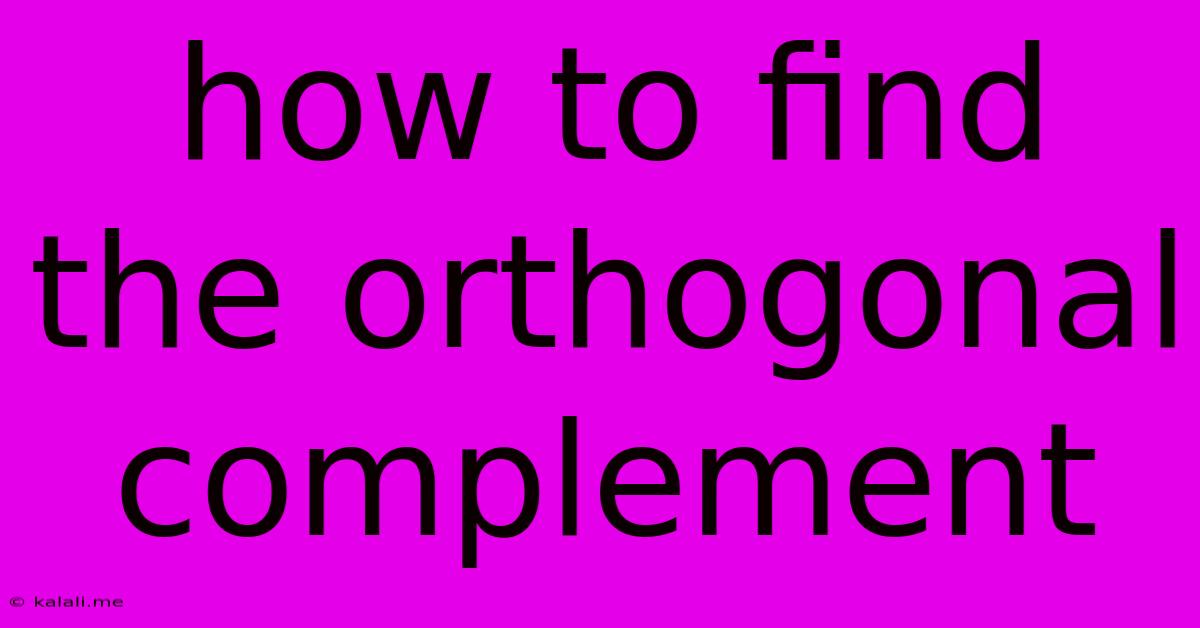How To Find The Orthogonal Complement
Kalali
Jun 07, 2025 · 4 min read

Table of Contents
How to Find the Orthogonal Complement: A Comprehensive Guide
Finding the orthogonal complement of a subspace is a fundamental concept in linear algebra with applications in various fields like machine learning, computer graphics, and quantum mechanics. This guide will walk you through the process, explaining the underlying theory and providing practical examples. Understanding orthogonal complements involves grasping the concepts of inner products, orthogonality, and basis vectors.
What is an Orthogonal Complement?
The orthogonal complement of a subspace W (denoted as W<sup>⊥</sup>) is the set of all vectors that are orthogonal (perpendicular) to every vector in W. In simpler terms, if you have a subspace, its orthogonal complement contains all the vectors that are "completely unrelated" or perpendicular to it. This means their inner product (dot product in R<sup>n</sup>) is zero.
Methods for Finding the Orthogonal Complement
The method for finding the orthogonal complement depends on how the subspace W is defined. Here are the most common scenarios:
1. When W is Defined by a Set of Linearly Independent Vectors
Let's say W is spanned by a set of linearly independent vectors {v<sub>1</sub>, v<sub>2</sub>, ..., v<sub>k</sub>}. To find W<sup>⊥</sup>, we need to solve the system of homogeneous linear equations:
v<sub>1</sub> ⋅ x = 0 v<sub>2</sub> ⋅ x = 0 ... v<sub>k</sub> ⋅ x = 0
where x is a vector in W<sup>⊥</sup> and ⋅ represents the inner product. This system can be represented as a matrix equation Ax = 0, where A is a matrix whose rows are the vectors v<sub>1</sub>, v<sub>2</sub>, ..., v<sub>k</sub>. Solving this system using techniques like Gaussian elimination will yield the basis vectors for W<sup>⊥</sup>.
Example:
Let W be spanned by v<sub>1</sub> = (1, 0, 1) and v<sub>2</sub> = (0, 1, 0). We want to find W<sup>⊥</sup>. The system of equations is:
(1, 0, 1) ⋅ (x, y, z) = 0 => x + z = 0 (0, 1, 0) ⋅ (x, y, z) = 0 => y = 0
Solving this gives z = -x and y = 0. Thus, the vectors in W<sup>⊥</sup> are of the form (x, 0, -x) = x(1, 0, -1). Therefore, a basis for W<sup>⊥</sup> is {(1, 0, -1)}.
2. When W is Defined as the Null Space of a Matrix
If W is the null space of a matrix A (meaning W = {x | Ax = 0}), then W<sup>⊥</sup> is the row space of A. The row space is the span of the rows of A. To find a basis for W<sup>⊥</sup>, you simply find a basis for the row space of A, typically by row reducing A to its row echelon form and selecting the non-zero rows.
Example:
Let A = [[1, 2, 3], [4, 5, 6]]. The null space of A is W. The row space of A (and therefore W<sup>⊥</sup>) is spanned by the linearly independent rows of A. While row reduction simplifies finding a basis, in this case, the rows (1, 2, 3) and (4, 5, 6) already form a basis for W<sup>⊥</sup>.
3. When W is Defined as the Column Space of a Matrix
If W is the column space of a matrix A, then W<sup>⊥</sup> is the null space of A<sup>T</sup> (the transpose of A). Find the null space of A<sup>T</sup> using the method described in section 2.
Important Properties of Orthogonal Complements
- Intersection: W ∩ W<sup>⊥</sup> = {0} (only the zero vector is in both subspaces).
- Direct Sum: V = W ⊕ W<sup>⊥</sup> (the entire vector space V is the direct sum of W and W<sup>⊥</sup>). This means every vector in V can be uniquely expressed as the sum of a vector in W and a vector in W<sup>⊥</sup>.
- Dimension: dim(W) + dim(W<sup>⊥</sup>) = dim(V)
Mastering the concept of orthogonal complements requires a solid understanding of linear algebra fundamentals. Practice with diverse examples will solidify your understanding and ability to solve problems efficiently. Remember to always consider the specific way your subspace is defined to select the most appropriate method.
Latest Posts
Latest Posts
-
Can You Do Nikah Without Parents
Jun 07, 2025
-
Does French Press Work On Induction Strove
Jun 07, 2025
-
Be Ye Perfect As I Am Perfect
Jun 07, 2025
-
Should You Have A Range For Desired Salary
Jun 07, 2025
-
Android Disable Long Press On Home Screen
Jun 07, 2025
Related Post
Thank you for visiting our website which covers about How To Find The Orthogonal Complement . We hope the information provided has been useful to you. Feel free to contact us if you have any questions or need further assistance. See you next time and don't miss to bookmark.